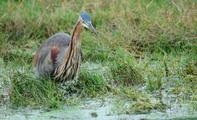
Name
Purple heron (Ardea purpurea)Purple Heron Appearance
The purple heron is a tall bird, standing around 85 m tall, but light for its size, weighing in at between 0.5 and 1 kgs. The purple heron has reddish-brown plumage, with a rusty coloured head and a streaky neck. The bill is narrow and yellow in colour. The purple heron has a black crown and a striped face. Yellow legs, the black facial markings and its size separate this heron from the Goliath heron.Purple Heron Diet
The purple heron prefers dense vegetation and rarely hunts in the open.The purple heron feeds mainly on fish but will feed on small mammals, insects, molluscs and juvenile birds. Small fish are swallowed head first. Larger prey is first killed on shore before being consumed. Small mammals and birds are often drowned by the heron, before being swallowed whole.